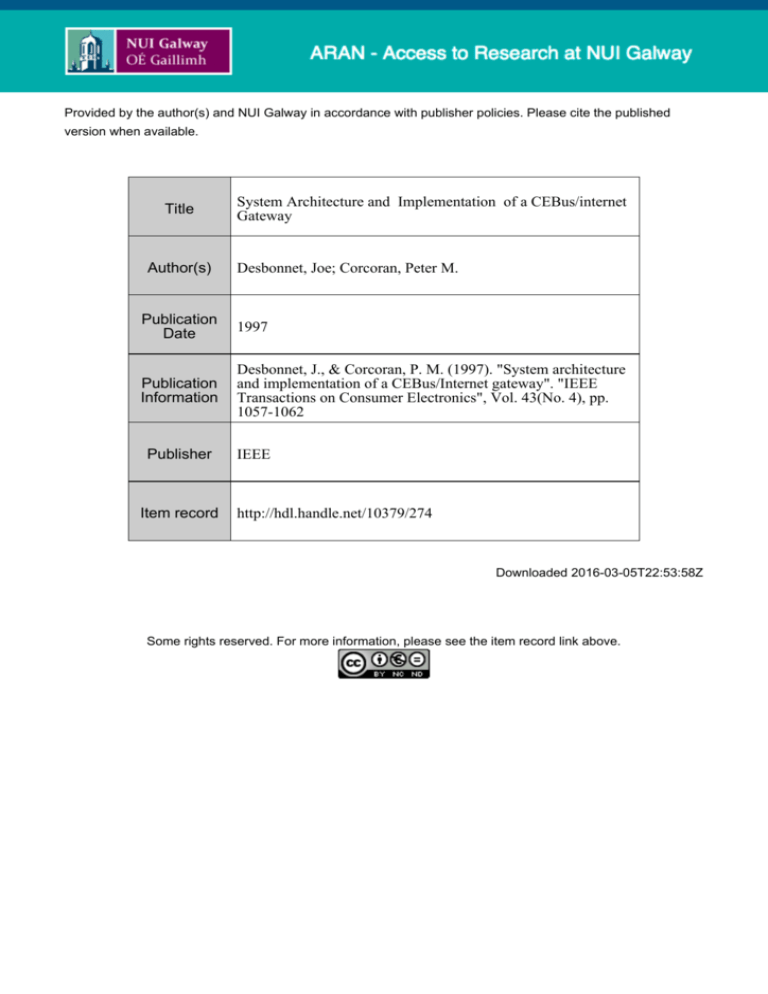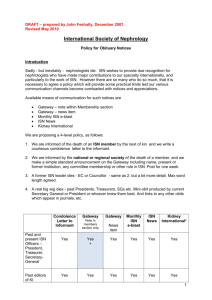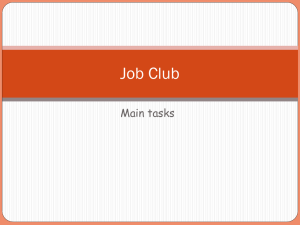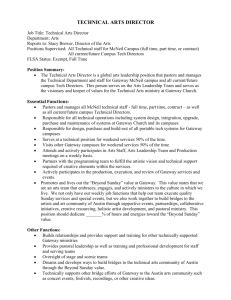
Provided by the author(s) and NUI Galway in accordance with publisher policies. Please cite the published
version when available.
Title
Author(s)
System Architecture and Implementation of a CEBus/internet
Gateway
Desbonnet, Joe; Corcoran, Peter M.
Publication
Date
1997
Publication
Information
Desbonnet, J., & Corcoran, P. M. (1997). "System architecture
and implementation of a CEBus/Internet gateway". "IEEE
Transactions on Consumer Electronics", Vol. 43(No. 4), pp.
1057-1062
Publisher
Item record
IEEE
http://hdl.handle.net/10379/274
Downloaded 2016-03-05T22:53:58Z
Some rights reserved. For more information, please see the item record link above.
~
Desbonnet and Corcoran: System Architecture and Implementation of a CEBushtemet Gateway
1057
SYSTEM ARCHITECTURE AND IMPLEMENTATION
OF A CEBus/lNTERNET GATEWAY
Joe Desbonnet and Peter M. Corcoran
Dept. of Electronic Engineering, University College, Galway, Ireland
Abstract - Class structures and an object-oriented software
framework to facilitate Internet access to CEBus networks are
described. The InterneffCEBus Gateway consists of a server
application and dynamic data structures which provide a
real-time representation of a CEBus network CEBus network
traffic is continually monitored and interpreted and these data
structures updated accordingly.
One service which we see as very significant in the
context of home automation networks is the ability
to access and download user-interface (UI) modules
for home network applicances. This issue of
providing a suitable user-interface to home
automation networks is covered in a companion
paper PI.
In addition the creation of "virtual" CEBus devices is
supported. These "virtual" devices can interact with the real
CEBus network This allows the creation of "new" device
personalities whose behaviour can then be characterised
through interaction with a real CEBus network
Note, that although we have taken the CEBus
networking standard as the basis for the
implementation of our gateway technology, it is not
confined to operating with CEBus networks. In fact
any home automation network which offers
supports for the Common Applications Language
(CAL) can be supported by our gateway
technology.
1. Introduction
The Consumer Electronic Bus (CEBusQ is a
multi-media LAN standard developed for home
automation applications [l]. In earlier work we
discussed some of the issues involved in providing
access to a CEBus network from a conventional
Web browser and Java@virtual machine JVM [2].
2. Design Goals for a Home Gateway.
In this paper we look at the next step in linking a
local control/automation network to the Internet, or
an equivalent WAN. As we shall discuss shortly,
we feel it is not very practical to attempt a direct
mapping of network addresses and protocols
between these two distinct networks. The
functionality and operation of a local control
network are somewhat different from those of a
wider bandwidth WAN network. Thus we shall
focus on the concept of an intelligent gateway
whosc function is to manage, broker and integrate
network traffic between these two distinct
categories of networks.
A central theme in our implementation of an
InternetKEBus gateway is that the system
architecture should be lightweight and platform
independent. This is particulary important in home
automation applications where "cost is king". Thus
although the penetration of desktop PC technology
into the home market is increasing on a daily basis
we still expect that most homes will not rely on a
home PC as the home gateway. Instead we expect
that a set-top-box style solution with a low-cost
embedded CPU will satisfy this need for most endusers.
Furthermore we see two distinctly different
approaches emerging in the field of home
automation: one approach is to incorporate TCP/IP
networking functionality into even the simplest of
consumer appliances. There are several drawbacks
to this approach. The current version of the
Internet Protocol (IP) allocates 32 bits for
addressing. As CEBus also requires 32 bits there is
not enough room to map every CEBus address to a
unique IP address. Also many embedded processors
used in comsumer devices are not powehl enough
to implement the IP protocol.
The functions of a home gateway can be sumarised
as follows:
0
acts as broker for WAN (outside world)
access to local network (home).
0
provides local (home) access to WAN
0
0
services & resources.
implements security & encryption services.
provides secure remote access across the
WAN (outside world) to local network
(home).
Manuscript received June 18, 1997
0098 3063/97 $10.00
@
1997 IEEE
IEEE Transactions on Consumer Electronics, Vol. 43, No. 4, NOVEMBER 1997
1058
network URLs - typically in the form of home interactive programlets, or HiPlets, as described in
[31.
/Remote
m
a
Fig 1: An Overview of the Home Gateway to the
Internet; some typical user services are shown.
The second approach, which we feel is more
realistic, is to integrate existing established
technologies, such as CEBus/CAL with the TCP/IP
infrastructure. With this approach only one device
- the gateway server - need be smart enough to
implement the IP protocol, and only one IP number
need be assigned per home. Current industry
initiatives, such as the proposed Home Plug and
Play (HPnP) standard [5], would appear to support
our thinking in this matter.
Thus the gateway can support a practically
unlimited variety of user-interface components.
2.4 Internet and CEBus Standards
As was mentioned above our prototype gateway
implementation is based on TCP/IP and CEBus
standards. This ensures that it has a broad
applicability in both industrial and home network
applications. Note, however, that the gateway
functionality is not confined to operating with
CEBus home networks and can, in principle,
support any home automation network which
supports CAL product models and CAL messaging.
3. Software Architecture
A central theme in our implementation of an
Internet/CEBus gateway is that the system software
architecture should be lightweight and platform
independent. To achieve these goal most of the key
system components have been implemented in
Java.
2.1 Scalability of the Gateway Architecture
The prototype gateway has beejn developed on a
standard desktop PC platform. However to support
scalability it has been almost entirely implemented
in the Java@ language. This should greatly simpliEy
the porting of the gateway to low-end embedded
applications such as Set-Top-Boxes and Web-TV
appliances.
2.2 Cross-Platform Portability
Again, as the core software components of the
system are implemented in Java it should be readily
portable across a broad range. of desktop and
embedded platforms. Some low-level interface
drivers may need to be written, but as the system is
built around TCPIIP network socket concepts and
CEBusB devices compliant with the common
application language (CAL,) the necessary low-level
software hooks should be quite generic.
2.3 Independent User Interface Modules
A further strategy to keep the gateway lightweight
and scalable is the approach to user-interface
issues. These are covered in more detail in a
companion paper [3], but essentially the gateway
interface only supports a simple device browsing
service. Independent user-interface elements for
each network device are loaded from external
Home
Network
Fig 2: Overview of the Soflare and Hara’ware
Components which make up the Gateway.
The primary components of our system are:
0
0
0
0
The IntemeVCEBus Gateway Server
CEBus/CAL Class Library
Virtual Devices
Interface hardware
3.1 InterneWEBus Gateway Server
The Gateway Server is a Java application that acts
as an intermediatry between applications and the
home
automation network.
The
server
communicates to the home automation network via
a propritery interface device, somewhat akin to a
conventional telephone modem. However this
hardware is somewhat more flexible than a simple
Desbonnet and Corcoran: System Architecture and Implementation of a CEBushternet Gateway
1059
modem and can allow virtual devices to interact
with the home automation network as if they were
real devices and had direct hardware access to the
network. This flexibility has some interesting
implications with respect to developing new
devices andor CAL product models.
As Java currently does not have a Serial I/O API
communications with the CEBus modem is
achieved using a simple server program written in
C which channels serial 1/0 to a TCP socket. Java
native methods could also be utilized to overcome
this limitiation.
Services which are currently provided by the
Gateway server to connecting applications include:
3.2 Virtual Devices and Networks
0
0
0
0
0
0
0
0
0
full/filtered packet dump
tx packet/&-ack packet
list network devices
lidseek device state info
listlseek house state info
list/seek context state info
select TCPLJDP broadcast
network statistics
MAC binding services
Note that much of the work on the gateway
software is still in the development stages and that
this list of services is changing quite frequently.
However the above list reflects some of the more
useful and important gateway services.
Applications request services from gateway by
establishing a TCP (Transfer Control Protocol)
socket and then exchanging a protocol similar to
HTTP (Hyper Text Transfer Protocol or World
Wide Web protocol) [RFC 1945, RFC 20681. Using
Secure Sockets Layer (SSL) full security can be
achieved, which is vital for any remote control or
remote metering applications. SSL will ensure that
all transactions are encrypted. It also provides a
means to authenticate the indentity of both parties
by using public key cryptography certificates.
A lighter communication protocol using UDP (User
Datagram Packets) has also been implemented.
The UDP packets to not incurr the overhead of
creating a TCP socket and thus is more suited to
heavy load situations (eg routing packets). However
UDP does not provide guaranteed delivery.
TCP
RS232
Fig 3: Structure of the Gateway S/W Components.
In the initial work to implement a prototype
gateway one problem we encountered was a
shortage of available CEBus compliant devices.
Most available devices which employ the CEBus
data transport are partly proprietary and as such are
not fully compatible with the EIA standard.
To over come this problem and assist in testing and
debugging our prototype gateway we set up a
second desktop PC with a virtual network of
CEBus devices. Network traffic from this simulated
network of devices was broadcast over the
powerline network, appearing to the gateway
system as if a real powerline CEBus actually
existed.
Virtual devices also provide a convenient
mechanism to implement a GUI to a home device
or sub system. For example a virtual device bound
to a GUI interface running on a set-top box could
act as the controller to the home security system
replacing the normal keypad controller fixed to the
wall.
3.3 Virtual CEBus Network: Class Libraries
A Java class library provides all the necessary tools
to construct CEBus devices and network and
implement CAL. The network can be run as a
standalone simulation on a computer or bridged to
other virtual or real networks.
Some of the main classes include: CEBusNetwork,
CEBusDevice, CALContext, CALObject, CALIV.
These are listed in Table I below with an
explanation of the primary function of each class
and their interrelationships as container objects.
BEE Transactions on Consumer Electronics, Vol. 43, No. 4, NOVEMBER 1997
1060
3.4 Bridgemouter
The bridgehouter is another Java application
allowing the interconnection of two or more real or
virtual CEBus networks, eg. linking buildings in
university campus via its TCP/IP infastructure.
I
I
TCPLP
WANLAN
Fig 4: Relationships between the Main System
Classes; Network, Device and Context Structures.
Class ID
Fig 5: CEBus networks internetworked using
TCPLP W,4N and bridgehouter application
CEBusNetwork
CEBusDevice
CALContexk
C&Context
Most of the CAL paning code
CALObject
GUI components can also
resister as an Observer of this
object - thus when an IV
changes they can be signaled
The bridge router application uses the lighter UDP
based gateway protocol to ensure fast response
times to CAI, query packets. In Fig 5 two CEBus
networks labeled ‘Network 1’ and ‘Network 2’ are
connected to a TCP/IP WAN via the Gateway
server. The current implementation of the
Bridgemouter adopts a simplistic approach
whereby a full packet dump is requested from both
networks. A list of devices on each network is
constructed and packets are forwarded accordingly.
3.5 Code Samples
CALIV
Table I: Main Gateway Classes
Class
Description
The following Java code fragment illustrates the
creation of a virtnal CEBus network of two devices:
a lamp and a dimmer switch. The reporting state of
the switch is set so that whenever its
‘current-value’ changes a packet setting the lamp
to the appropriate illumination value will be
generated.
Note: some declaration and
initialization code has been omitted to improve
clarity.
I
CEBusAddress
First a virtual CEBus network is created:
I1 Create CEBus Network
CEBusNetwork mynet = new CEBusNetworkO;
The next block of code creates a light dimmer
switch with house code 1, unit code 1.
.
Table 11: Supplemental Utility Classes
Desbonnet and Corcoran: System Architecture and Implementation of a CEBushtemet Gateway
I/ Create light dimmer switch (house 1, unit 1)
CEBusDevice myswitch
= new CEBusDevice( 1 , l ) ;
packet is formed by appending the report value to
the supplied CAT, header. In this case the header
instructs the lamp to set its current value (labeled
.'CY) to the dimmer switch current value.
/I Set reporting on switch
byte [] calhead = new byte [5];
It is identified as device model "SWOOl" from a
fictitious "Acme Inc." vendor.
calhead[O]=CAL.CONTEXT-LIGHTING;
calhead[l]=2; / I Send to object #2
calhead['Z]=CAL.METHOD-SETVALUE;
cal head[3]='C';
cal head[4]=CAL.TOKEN-DELlMlTER;
sensor.setlV("report-address",
mylamp.getAddress( ));
sensor.setlV("report-header", calhead);
I/ Create Universal Context & Node Control
switch-univctx = new UniversalContext();
switch-nodectl = new NodeControl()
switch-nodectl.setlV("manuf-name","Acme
Inc.");
switch-nodectl.setlV("manuf_model","SWOOl");
switch-univctx.addObject( switch-nodectl);
myswitch.addContext( switch-univctx);
A lighting context is created with an Analogsensor
object as object #3 according to the CEBus
specification.
/ I Create Lighting Context & Sensor object
switch-lightctx = new LightingContextO;
sensor = new Analogsensor();
switch-lig htctx.addObject(sensor, 3);
myswitch. addcontext( switch-l ightctx);
A lamp is now created with unit code 2.
I/ Create lamp (house 1, unit 2)
I/
Device mylamp = new Lamp(l,2);
I/ Create Universal Context & Node Control
1061
Finally register these devices with the network and
launch the network browser.
I
/ I Register devices with network
mynet.addDevice(myswitch);
mynet.addDevice(mylamp);
/ I Launch network browser
Frame f = new NetworkBrowser(mynet);
f.s how();
When executed the device browser window (Fig 6)
appears on the desk top. A list of all registered
devices appears along the top. Clicking on the
'Browse' button for a given device launches it's
'Device Browser' (Fig 7).
The device browser provides a graphical
representation of all objects in the device grouped
by context.
lamp-univctx = new UniversalContext();
lamp-nodectl = new NodeControl()
lam p-nodectl. set IV(" manuf-n a me","Acme Inc." );
lamp-nodectl.setlV("manuf~model","LAMPOl");
lamp-univctx.addObject(lamp-nodectl);
mylamp.addContext( lamp-univctx);
I/
/ I Create Lighting Context & Control object
lamp-lightctx = new LightingContextO;
lightlevel = new AnalogControl();
lamp-lig htctx.addObject( lightlevel,2);
mylamp.addContext(light-lightctx);
Next the dimmer switch is configured to send
report packets to the lamp. The CAL header is
constructed in byte array "calhead'. The report
I
Fig 6: Network Browser Applet
IEEE Transactions on Consumer Electronics, Vol. 43, No. 4, NOVEMBER 1997
1062
Networks”. ICCE ‘97 - IEEE Conference on
Consumer Electronics, Chicago Il, Jun. 1997.
[4] EIA Home Automation System (CEBus)
Standard IS-60, “Common Application
Language Specifications”, EIA, Part 8, June
29h 1992.
[5] Home Plug and Play Specification, “CAL-based
interoperability for Home Systems”, CEBus
Industry Council (CIC), April 2nd, 1997;
“http://www.cebus.orglhpnp/”.
Fig 7: Device Browser
Biographies
5. Conclusions and Future Work
Advanced security ... concept of groups of devices
and operation classes eg some users can have ‘read’
access to some devices but not write etc
Home script - a secure scripting language to allow
smart agents to run on the gateway server. These
agents
REFERENCES
[ 11 Hofmann, J., “The Consumer Electronic Bus:
An Integrated Multi-Media LAN for the
Home”, International Journal of Digital and
Analog Communication Systems, Vol. 4,No. 2,
Apr. 1991, pp. 77-86, i99i.
[2] Desbonnet, J., Corcoran P.M., and Lusted, K.,
“CEBus Network Access via the World-WideWeb“,IEEE Trans. Consumer Electronics, Aug.
1996.
[ 3 ] Corcoran P. M. and
Desbonnet, J., “Web
Browser and Applet Interfaces to CEBus
Corcoran received the BAI (Electronic
Engineering) and BA (Maths) degrees from Trinity
College Dublin in 1984. He continued his studies at
TCD and was awarded a Ph.D. in Electronic Engineering
in 1987 for research work in the field of Dielectric
Liquids. In 1986 he was appointed to a lecturship in
University College Galway. He is involved in
international Joint-Venture projects in both China and
Eastern Europe. He is currently teaching on a full-time
basis at University College Galway. His current research
interests include home automation networks, Internet
technologies, embedded computing applications, and
telecommunications technologies. He is a member of the
IEEE and a technical committee member of the IEEE
Consumer Electronics Society.
Peter
Joe Desbonnet received his B.Sc. degree in Physics and
Electronics from University College Galway in 1993. He
site
at
has
run
a
professional WWW
http://www.wombat.ie since 1992. He is presently
working as a Research Associate at University College
Galway and is a director of World-Wide-Web Marketing,
a Galway based Internet services company.







